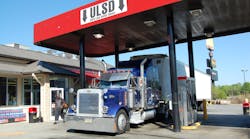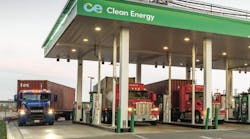Average retail pump prices for diesel and gasoline increased slightly week-over-week, according to data tracked by the Energy Information Administration (EIA), even as a major cold snap settled over much of the nation in the early days of 2014.
The national average for diesel increased 7/10ths of a penny to $3.910 per gallon this week, the agency noted, which is a tenth of a penny per gallon cheaper versus the same week in 2013. EIA also noted that diesel prices increased in all regions of the country this week except for the Lower Atlantic, where average prices declined 9/10ths of a penny per gallon.
Diesel crested the $4 per gallon mark this week in four U.S. regions: New England ($4.115 per gallon), the Gulf Coast ($4.119), the West Coast ($4.034, but dropping to $3.934 when California is excluded), and California ($4.046).
The EIA said California witnessed the biggest week-over-week increase in diesel prices at 1.5 cents per gallon, followed by the Gulf Coast with a 1.3 cent per gallon uptick and the Rock Mountain region with a 1.2 cent per gallon jump.
The national average for gasoline only inched up slightly this week, EIA pointed out, rising one tenth of a penny to $3.332 per gallon, which is actually 3.3 cents per gallon higher compared to the same week in 2013. New England recorded the highest average gasoline price for the week in the U.S. at $3.556 per gallon, with the Rock Mountain region reporting the lowest at $3.12 per gallon.
The Midwest witnessed the only decline in gasoline prices this week – a 4.2 cent per gallon drop – with prices jumping the most in the Lower Atlantic region (a 3.3 cent per gallon boost), the East Coast (a 2.5 cent per gallon jump), and out on the West Coast with California’s prices factored in (a 2.1 cent increase) and taken out (a 2.4 cent per gallon uptick).
EIA also noted that an interesting change occurred in the correlation of commodity prices in the latter half of 2013, especially where oil futures are concerned.
In recent years, the agency found that changes in crude oil futures pricing moved in tandem with the price changes of other commodities. Yet such correlations declined in the latter half of 2013, indicating that commodity sector prices responded to factors in their respective markets rather than broad shifts in expectations of global economic growth, which tends to increase or decrease the prices of all commodities. As a result, EIA said prices for major crude oil benchmarks and petroleum products ended 2013 mostly flat or down.
U.S. natural gas prices ended higher in 2013 as cold weather across much of the country drove prices well above $4 per million British thermal units ($/MMBtu) in both the physical and financial markets. As a result, natural gas prices were 50 cents to $1/MMBtu above their level at the start of the year.
However, though heating oil prices increased in 2013 because of strong global demand for diesel fuel and inventories declined to nearly five-year lows, EIA said gasoline prices as fell largely because abundant supplies were produced as a result of the high refinery runs needed to satisfy demand for heating oil and diesel fuel.



